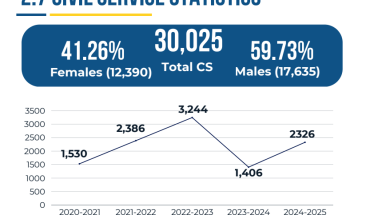
DAWA ZANGMO
Thimphu
he Royal Monetary Authority (RMA) has announced the implementation of seven new monetary measures aimed at supporting loan repayments and improving the financial stability of the country’s banking sector.
These measures, set to be enforced after June this year, mark a strategic shift from the blanket loan deferment approach that was adopted during the COVID-19 pandemic.
According to the central bank, the newly introduced framework will replace the long-standing deferment system with a more structured and individualized strategy focused on viable borrowers.
A three-month transition period will begin in July to allow financial institutions time to consult borrowers and assess the viability of their loans before the full-scale rollout of the measures.
The RMA emphasized that unlike the emergency blanket loan deferments applied during the height of the pandemic, the forthcoming approach will focus on reducing non-performing loans and supporting only those borrowers who demonstrate the ability to repay.
During a press conference held on June 6, RMA officials stated that the government had provided one of the most extensive and longest-running blanket loan deferments globally.
The deferments, which began in April 2020, continued uninterrupted until June 2024, making Bhutan the only country to implement such relief measures for five consecutive years.
These blanket deferments were introduced as a temporary financial relief measure during the pandemic. Under this arrangement, all borrowers were granted loan repayment deferrals regardless of their financial status or capacity to repay.
While the scheme provided immediate relief and prevented large-scale defaults during a period of global uncertainty, RMA officials noted that it also had significant unintended consequences.
The prolonged deferment period led to a growing accumulation of unpaid interest and overall debt. By April 2024, the interest accrued on deferred loans had reached Nu 4.7 billion. Furthermore, data as of March 2025 showed that loan deferrals across eight financial service providers amounted to over Nu 29.6 billion.
The RMA indicated that the extended deferment scheme inadvertently created a misleading sense of financial security for many borrowers. This, in turn, negatively affected the financial health of lending institutions by reducing asset quality and limiting their ability to issue new loans.
Financial institutions also encountered difficulty in distinguishing genuinely distressed borrowers from those who were financially capable of making repayments but chose not to do so under the blanket scheme.
According to the RMA, the extended deferments have placed additional pressure on the country’s financial institutions.
Prolonged repayment holidays diminished banks’ ability to generate regular income from loan repayments, making it harder to maintain asset quality and meet new lending demands.
As a result, future loan availability and the overall credit environment were at risk.
In light of these challenges, the RMA has decided to transition to a more sustainable loan repayment support model. The revised strategy emphasizes loan viability assessments, borrower accountability, and institutional resilience.
RMA officials clarified that blanket deferments would no longer be considered a viable policy option, given their unsustainable impact on the broader financial system.
As part of the new approach, the RMA will implement a series of seven restructuring measures detailed in the Loan Restructuring Rules and Regulations 2022.
These measures are specifically designed to assist viable borrower’s individuals and businesses who demonstrate a credible ability to repay their loans over time.
The RMA has instructed financial institutions to apply these restructuring options based on an evaluation of each borrower’s financial condition and repayment capacity.
The seven measures include various options tailored to meet different financial needs and challenges faced by borrowers.
The first restructuring option is the interest-only payment, which allows borrowers to pay only the interest component of their Equated Monthly Installments (EMIs) for a period of up to two years.
This approach temporarily eases the financial burden without requiring immediate repayment of the principal amount.
The second option is the payment moratorium, which provides a temporary suspension of all loan repayments for borrowers experiencing short-term cash flow issues.
The third restructuring method is capitalization, where accumulated interest is added to the principal amount of the loan. Borrowers can then seek an extension of the loan’s repayment term, resulting in a revised schedule that reflects the adjusted total loan value.
The fourth option is the extension of the loan maturity term. For example, if a borrower initially took a loan for five years, the repayment term can be extended to six, seven, or even eight years.
The fifth restructuring mechanism is loan top-up with collateral, allowing borrowers to access additional loans using existing or new collateral. The move is intended to provide liquidity support and consolidate financial obligations under manageable repayment conditions.
The sixth option is loan splitting, which enables borrowers with large loans to divide them into two or more smaller loans. Borrowers can then repay these segments according to their financial capabilities, reducing the strain of managing a single large repayment.
The seventh and final measure is the conversion of overdraft or working capital loans into term loans. It involves restructuring revolving credit facilities into fixed-term loans with clearly defined repayment schedules monthly, quarterly, or annually thereby introducing a more disciplined repayment structure.
In addition to these standardized restructuring options, the RMA has permitted financial institutions to propose and implement additional restructuring mechanisms, provided they receive approval from their respective boards.
The new measures were finalized following consultations with key stakeholders, including the Prime Minister’s Office, the Ministry of Finance, and representatives from various financial institutions.
The coordinated decision-making process reflects a national consensus on the need to support borrowers without compromising the financial sector’s stability.
To facilitate the smooth implementation of the new loan restructuring measures, the RMA has allowed a three-month transition period starting in July.
During this phase, financial institutions will be expected to engage with borrowers, assess their loan profiles, and determine the most appropriate restructuring solutions.
This transition period is also intended to ensure that borrowers are fully informed of the changes and are given sufficient time to understand their options.
Financial institutions have been urged to strengthen communication and provide guidance to clients who may be eligible for one or more of the restructuring measures.
The RMA’s shift from blanket deferments to a targeted restructuring framework marks a pivotal moment in Bhutan’s post-pandemic financial recovery.
The new measures are designed not only to ease repayment burdens for distressed but viable borrowers but also to ensure the long-term resilience of the country’s banking sector.
With the end of the five-year blanket deferment scheme, the focus is now on restoring normal loan servicing practices while offering structured support to those in need.
The RMA’s new strategy aims to balance financial compassion with institutional responsibility, creating a more sustainable credit environment.
Financial institutions are expected to play a proactive role in implementing the restructuring measures and monitoring the performance of restructured loans.
The central bank will continue to provide oversight and guidance as needed to ensure effective execution and adherence to regulatory standards.




